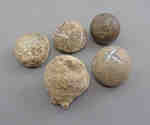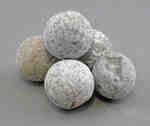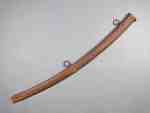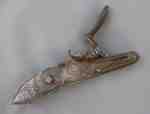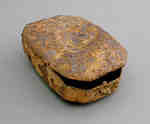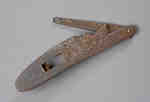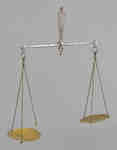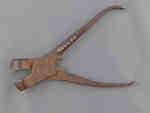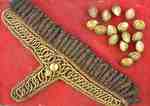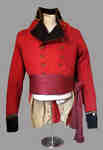Résultats
- This is a black leather bayonet sheath that measures 37.5cm in length. There is also a frog clip that was used to mount it on a belt. Stamped into the sheath near the frog clip are the markings: “E”,This is a black leather bayonet sheath that measures 37.5cm in length. …
- These musket balls were found at one of Niagara's battlefield sites. It appears, due to their deformation, that they have been fired from a musket.These musket balls were found at one of Niagara's battlefield sites. It …
- A collection of musket balls found at one of Niagara's battlefield sites. Sizes range from 1.8 to 1.5 to 1.2 cms.A collection of musket balls found at one of Niagara's battlefield sites. …
- A scabbard with a gilt top was part of an infantry officer’s sheath, pattern 1796. It is black leather with gilt binding, frog clip and sash ring. The top gilt piece has become detached from the leatA scabbard with a gilt top was part of an infantry officer’s …
- A steel military scabbard that is curved with two metal bands with a ring attached to each. The metal is dull and rusty and the tip is broken off.A steel military scabbard that is curved with two metal bands with …
- A curved steel scabbard that is said to have been found on the Lundy's Lane Battlefield by W. W. Woodruff.A curved steel scabbard that is said to have been found on …
- A British Officer’s sword and scabbard. The scabbard is black leather with a brass tip and collar with a ring. The sword has an urn hilted pommel with a fixed guard and the hilt is wrapped with wire.A British Officer’s sword and scabbard. The scabbard is black leather with …
- A musket action with “TOWER”, a crown and the Royal cipher “GR” engraved on one side.A musket action with “TOWER”, a crown and the Royal cipher “GR” …
- A Brown Bess rifle, commonly called an India Pattern Musket, that has been previously converted from a flintlock to a percussion action. It is a single 39 inch barrel with three ram rod pipes. ThereA Brown Bess rifle, commonly called an India Pattern Musket, that has …
- This is a snuff box believed to be from the Battle of Lundy’s Lane which can be found at the Battleground Hotel Museum. Snuff boxes were used to hold powdered tobacco which was often sniffed throughThis is a snuff box believed to be from the Battle of …
- This is a musket action piece that has ornate markings on one side. This item is currently on display at the Battleground Hotel Museum.This is a musket action piece that has ornate markings on one …
- These are cannon balls from the Battleground Hotel Museum.These are cannon balls from the Battleground Hotel Museum.
- This is a military trench shovel that is made of one piece of forged steel. The shovel is 43.2 cm in length. It is believed that the British used this shovel during the War of 1812-1814.This is a military trench shovel that is made of one piece …
- This is an incomplete telescope that was said to have been used in the gallery at the top of the original Brock's monument which was blown up by Benjamin Lett in 1840. The telescope is 43 cm long andThis is an incomplete telescope that was said to have been used …
- This is a weigh scale that was used for measuring gold. It has two gold coloured weigh pans attached to the fulcrum by dark brown cord. The case is made of walnut and is lined with dark coloured velvThis is a weigh scale that was used for measuring gold. It …
- This is a musket ball mold of a plier design. It was used to press a musket ball to the proper size calibre. The press end is hollow and rounded with a hole at one end for pouring in molten metal andThis is a musket ball mold of a plier design. It was …
- Accession Numbers: 961.D.42A- Coatee 961.D.42B- Trousers 961.D.42C- HatAccession Numbers: 961.D.42A- Coatee 961.D.42B- Trousers 961.D.42C- Hat
- This is a military insignia composed of an epaulet from a Grenadier Company with their brass insignia of a flaming bomb and 17 brass buttons. The buttons also have the Royal Crown insignia. These iteThis is a military insignia composed of an epaulet from a Grenadier …
- This is an Upper Canadian British militia officer’s coatee of the sedentary militia. It conforms to the regulations of 21 June, 1814, which specifies that all officers on duty shall appear in a scarlThis is an Upper Canadian British militia officer’s coatee of the sedentary …







